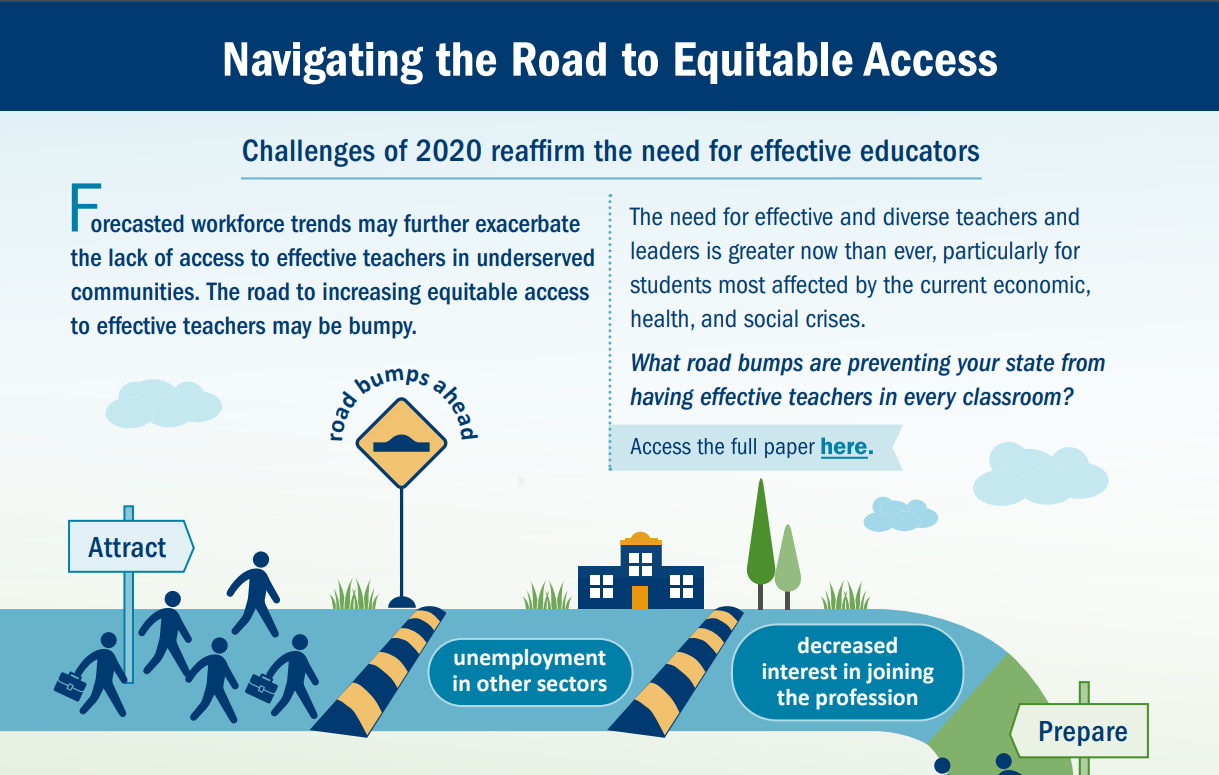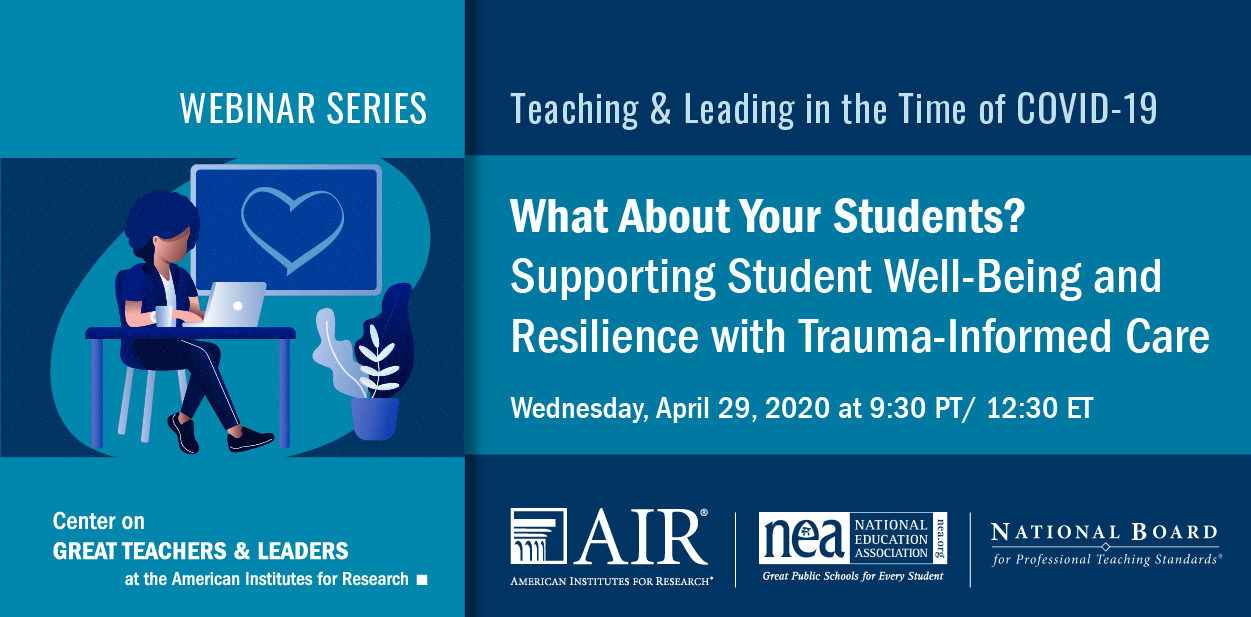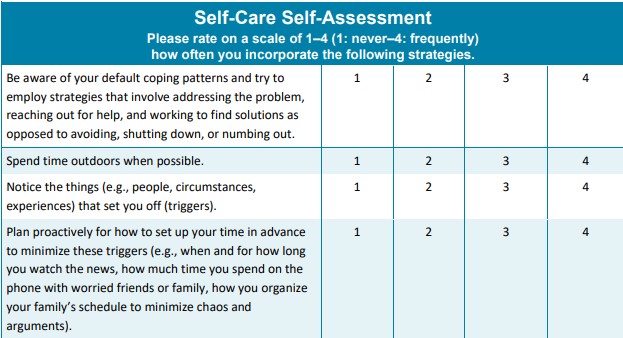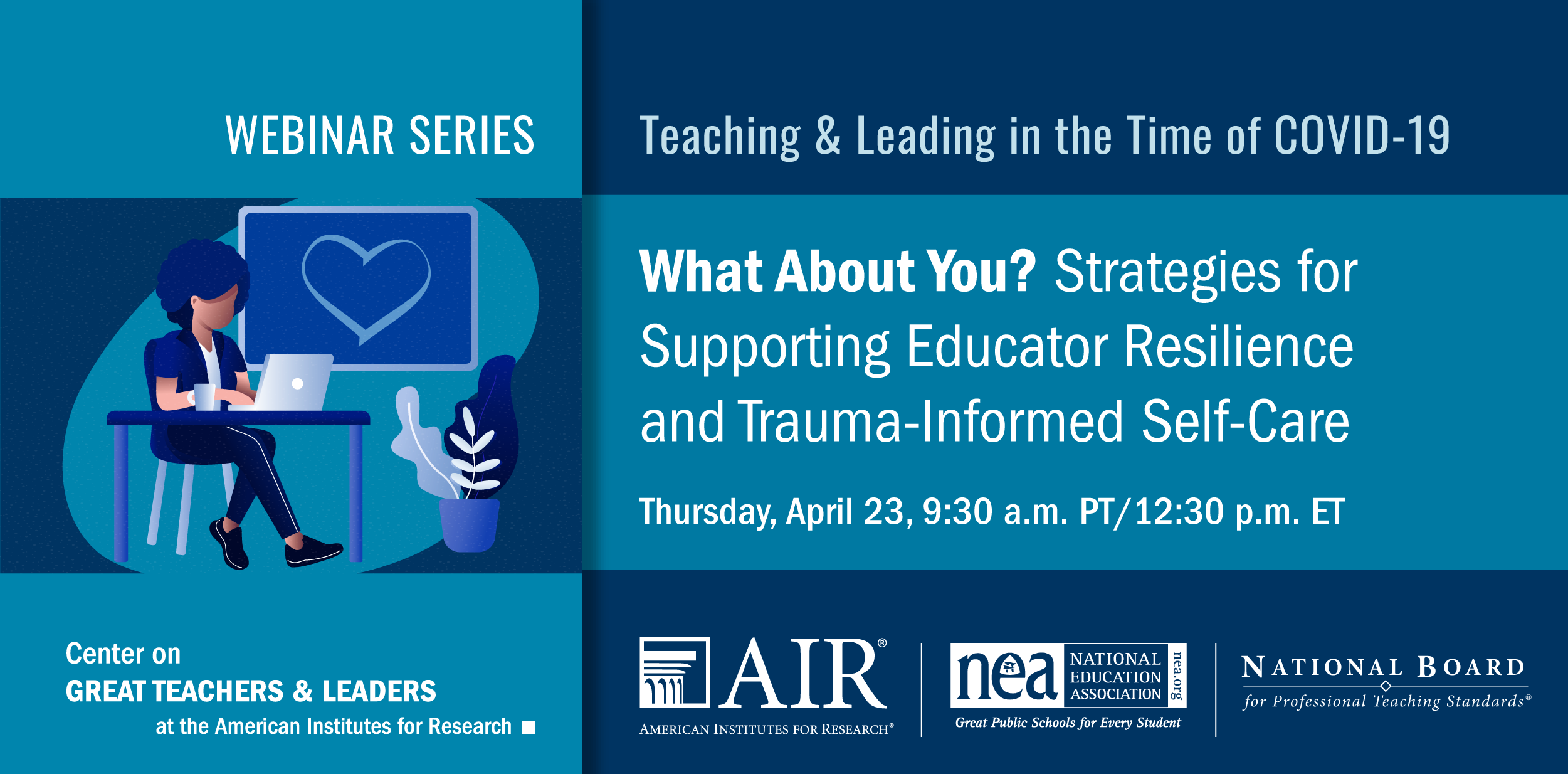Covid-19

Educators across the country are supporting students, parents and their communities with innovative practices and thoughtful solutions to the unprecedented COVID-19 crisis.
The GTL Center team is supporting states, districts, and their educators in their momentous efforts by gathering and sharing practical resources around the following topics:
- Teaching through Distance Learning
- Distance Learning for Students with Disabilities
- Distance Learning for English Language Learners
- Distance Learning in Early Education
- Supporting Teacher Well-Being
- Supporting Student Well-Being
- Communications
- Virtual Talent Management
- Virtual Professional Learning for Educators
- COVID-19 Impacts on K-12 Policy
Please note, this page is still under development with resources being added daily. Not every topic above will have resources available yet, so check back soon!
For now, explore our top resources under the available topics by first selecting your role: are you an educator, district leader, or state leader?

During this webinar, Randi Weingarten, the President of the American Federation of Teachers and Dan Domenech, Executive Director of the America Association of School Administrators share how collaborative problem solving within and among school districts will be essential to finding operational solutions that can balance safety, equity of access for all children, and budgetary constraints, while addressing the needs of working parents.

Remote learning requires adjustment for all students, but students with disabilities face additional challenges during the COVID-19 quarantine. In this episode of AIR Informs, Allison Gandhi describes some of these obstacles, as well as strategies to help students, schools, and families make the most of this time.

This plan from the American Federation of Teachers is based on five pillars and includes guidance handling emergent cases of COVID-19, entry process/screening, protections for staff and schools, and how to reorganize schools to promote social distancing.

This website provides a repository of instructional materials and tools for online learning. It includes instructional materials for students in grades K–9 for ELA, math, and science.

This first webinar in a new series explores how educators can better prepare themselves to face the challenges of COVID-19 by using trauma-informed self-care and resilience-building strategies.
























This toolkit is based on insights from surveys, case studies, and meetings with experts in the field and aims to support educators in using technology to help their English learners gain proficiency in English and meet academic goals.
This study examined how districts and teachers identify and use digital learning resources, as well as supports for and barriers to using digital learning resources. It also includes suggestions for improving the usefulness of digital learning resources instruction for EL students.
As instruction shifts to an online format, teachers need strategies to provide differentiated instruction for students with disabilities. In this webinar, veteran online instructors identify strategies for adapting lessons already in motion to this new format.
This webinar available via Facebook highlights communication, collaboration and regular routines as among the keys to successful online education for students with disabilities.
This short guide highlights four actions educators can take to support their students with disabilities during the transition to online learning.
This list of resources focuses on how best to meet the needs of students with disabilities in an online environment.
This FAQ offers links to examples and resources focused on how schools and districts can find creative ways to support students and families with limited access to technology.
This guide covers strategies for instruction and grading when implementing remote learning. It includes guidance on the duration of learning by grade level, suggestions for activities, ways to support multilingual education, and special education delivery.
This webinar highlights strategies for effectively teaching K-12 students in virtual settings, and includes presentations from an e-learning expert and two educators who shared approaches they are using to connect with students, build lesson plans, and manage student work in a virtual environment
The FAQs cover pressing COVID-19 topics like providing Free and Reduced Lunches, supporting students’ social emotional needs, transitioning to online instruction, and addressing equity concerns for students with limited access to technology, students with disabilities, and English learners.
The resource list provides options for creating a foundation for communication, sharing, and digital learning, tips for successful distance learning, and examples from district websites offering daily academic and social-emotional lessons for students.

School leaders face unique challenges and opportunities as they work to reopen schools and create school communities that address the intersection between adversity, well-being, and academic success. This handout offers a self-assessment for school leaders that includes an array of trauma-informed strategies for fostering trust, wellbeing, and resilience for all in the learning environment during these unprecedented times.

During this webinar, Randi Weingarten, the President of the American Federation of Teachers and Dan Domenech, Executive Director of the America Association of School Administrators share how collaborative problem solving within and among school districts will be essential to finding operational solutions that can balance safety, equity of access for all children, and budgetary constraints, while addressing the needs of working parents.

This guidance outlines what safety measures are required and recommended to reopen schools. It includes a decision tree for opening schools and templates for screening students to enter schools.

Remote learning requires adjustment for all students, but students with disabilities face additional challenges during the COVID-19 quarantine. In this episode of AIR Informs, Allison Gandhi describes some of these obstacles, as well as strategies to help students, schools, and families make the most of this time.

This web page includes essential actions and guidance for district and school leaders to plan and implement a safe and equitable return to school. It focuses on governance, wellness, instruction, facilities, school operations, and technology.

This plan from the American Federation of Teachers is based on five pillars and includes guidance handling emergent cases of COVID-19, entry process/screening, protections for staff and schools, and how to reorganize schools to promote social distancing.

This guide provides a framework for helping districts develop guidelines for opening schools. It recommends developing a taskforce and work groups to develop recommendations and plans to open schools and guiding questions for each work group.

Chiefs for Change developed guidance for returning to school in the fall. It include guidance on the school calendar, school staffing models, social and emotional well-being, and instructional materials.

This guide outlines possible school configurations to re-open schools in the fall in light of COVID-19.

The Pennsylvania Department of Education develop preliminary guidance to help districts and schools open school. It includes guidance around developing health and safety plans and key considerations for each phase of re-opening.

This is Maryland's draft guidance for schools in the Fall of 2020. The plan provides guidance around instructional programs, support programs, professional learning, preparation services, student services, and health considerations.

This paper describes the options available to districts for grading policies in light of COVID-19. It highlights the policies in California districts, districts around the country, and approaches that address equity.

This document outlines key considerations for opening schools in the fall in light of COVID-19. It addresses school operations, whole child supports, school personnel, academics, and distance learning.

This first webinar in a new series explores how educators can better prepare themselves to face the challenges of COVID-19 by using trauma-informed self-care and resilience-building strategies.





















This study examined how districts and teachers identify and use digital learning resources, as well as supports for and barriers to using digital learning resources. It also includes suggestions for improving the usefulness of digital learning resources instruction for EL students.
In this webinar, leaders in special education present current information on COVID-19, how special education administrators are navigating these challenges, and options for meeting the needs of families and students.
This FAQ provides links to resources and examples from Washington, New York, Colorado, Illinois, and Michigan on methods to provide online instructional support to students with disabilities.
This webinar available via Facebook highlights communication, collaboration and regular routines as among the keys to successful online education for students with disabilities.
This FAQ offers links to examples and resources focused on how schools and districts can find creative ways to support students and families with limited access to technology.
This guide covers strategies for instruction and grading when implementing remote learning. It includes guidance on the duration of learning by grade level, suggestions for activities, ways to support multilingual education, and special education delivery.
The FAQs cover pressing COVID-19 topics like providing Free and Reduced Lunches, supporting students’ social emotional needs, transitioning to online instruction, and addressing equity concerns for students with limited access to technology, students with disabilities, and English learners.
The resource list provides options for creating a foundation for communication, sharing, and digital learning, tips for successful distance learning, and examples from district websites offering daily academic and social-emotional lessons for students.

School leaders face unique challenges and opportunities as they work to reopen schools and create school communities that address the intersection between adversity, well-being, and academic success. This handout offers a self-assessment for school leaders that includes an array of trauma-informed strategies for fostering trust, wellbeing, and resilience for all in the learning environment during these unprecedented times.

During this webinar, Randi Weingarten, the President of the American Federation of Teachers and Dan Domenech, Executive Director of the America Association of School Administrators share how collaborative problem solving within and among school districts will be essential to finding operational solutions that can balance safety, equity of access for all children, and budgetary constraints, while addressing the needs of working parents.

This guidance outlines what safety measures are required and recommended to reopen schools. It includes a decision tree for opening schools and templates for screening students to enter schools.

REL Central compiled a list of resources on what states might do to address educator certification. It includes examples from states and resources for alternative certifications.

This web page includes essential actions and guidance for district and school leaders to plan and implement a safe and equitable return to school. It focuses on governance, wellness, instruction, facilities, school operations, and technology.

This plan from the American Federation of Teachers is based on five pillars and includes guidance handling emergent cases of COVID-19, entry process/screening, protections for staff and schools, and how to reorganize schools to promote social distancing.

This guide provides a framework for helping districts develop guidelines for opening schools. It recommends developing a taskforce and work groups to develop recommendations and plans to open schools and guiding questions for each work group.

Chiefs for Change developed guidance for returning to school in the fall. It include guidance on the school calendar, school staffing models, social and emotional well-being, and instructional materials.

This guide outlines possible school configurations to re-open schools in the fall in light of COVID-19.

The Pennsylvania Department of Education develop preliminary guidance to help districts and schools open school. It includes guidance around developing health and safety plans and key considerations for each phase of re-opening.

This is Maryland's draft guidance for schools in the Fall of 2020. The plan provides guidance around instructional programs, support programs, professional learning, preparation services, student services, and health considerations.

This document outlines key considerations for opening schools in the fall in light of COVID-19. It addresses school operations, whole child supports, school personnel, academics, and distance learning.










This study examined how districts and teachers identify and use digital learning resources, as well as supports for and barriers to using digital learning resources. It also includes suggestions for improving the usefulness of digital learning resources instruction for EL students.
In this webinar, leaders in special education present current information on COVID-19, how special education administrators are navigating these challenges, and options for meeting the needs of families and students.
This FAQ provides links to resources and examples from Washington, New York, Colorado, Illinois, and Michigan on methods to provide online instructional support to students with disabilities.
This guide covers strategies for instruction and grading when implementing remote learning. It includes guidance on the duration of learning by grade level, suggestions for activities, ways to support multilingual education, and special education delivery.
This list includes resources and tools from government organizations, federal grantees, and public entities that help everyone-from policymakers to families-understand how to transition from traditional classroom settings to home-based learning through online resources.
The FAQs cover pressing COVID-19 topics like providing Free and Reduced Lunches, supporting students’ social emotional needs, transitioning to online instruction, and addressing equity concerns for students with limited access to technology, students with disabilities, and English learners.
The resource list provides options for creating a foundation for communication, sharing, and digital learning, tips for successful distance learning, and examples from district websites offering daily academic and social-emotional lessons for students.











